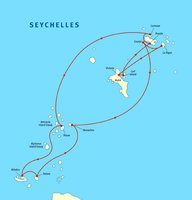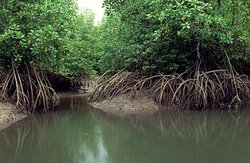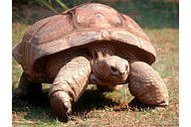Aldabra Atoll, Seychelles
| Topics: |
Contents
- 1 Introduction
- 2 Geographical Location
- 3 Date and History of Establishment
- 4 Area
- 5 Land Tenure
- 6 Altitude
- 7 Physical Features
- 8 Climate
- 9 Vegetation
- 10 Fauna
- 11 Cultural Heritage
- 12 Local Human Population
- 13 Visitors and Visitor Facilities
- 14 Scientific Research and Facilities
- 15 Conservation Value
- 16 Conservation Management
- 17 IUCN Management Category
- 18 Further Reading
Introduction
Aldabra Atoll (9°25'S, 46°25'E) is a World Heritage Site and is located in the Indian Ocean. (Aldabra Atoll, Seychelles)
Geographical Location
An atoll in the Mozambique Channel, situated approximately 400 kilometers (km) north-west of Madagascar and 680 km east of the East African mainland. 9°25'S, 46°25'E
Date and History of Establishment

Designated a strict nature reserve on 17 February 1976 under the Protection and Preservation of Wild Life Ordinance, 1970 (BIOT) and a special reserve by Designation of Special Reserve (Aldabra) Order, 1981. Inscribed on the World Heritage List in 1982.
Area
35,000 hectares (ha) (terrestrial: 18,800 ha; mangrove: 2,000 ha; marine: 14,200 ha).
Land Tenure
Government, administered by the Seychelles Island Foundation. The Royal Society acquired a 14-year lease in 1976 from the Government of the British Indian Ocean Territory. This was then taken over in 1980 by the Seychelles Islands Foundation, a charitable trust established under the Seychelles Islands Foundation Decree 1979.
Altitude
Most of the reserve is about 8 meters (m) above sea level.
Physical Features
Aldabra is a classic coral atoll, 34 km long by maximum of 14.5 km wide, which has been built up from the seabed. It comprises four main islands of coral limestone separated by narrow passes and encloses a large shallow lagoon. Most of the land surface comprises ancient coral reef (about 125,000 years old) now raised above sea level, the rest being even older reef limestones. The lagoon, which covers some 14,000 ha, contains many smaller islands and the entire atoll is surrounded by an outer reef. Geomorphological processes have produced a varied and generally rugged topography. Weathering has eroded the limestone into holes and pits over much of the surface of the islands, although the surface at the eastern end is comprises raised lagoonal sediments. The limestone cliffs along the coast are undercut, and there is a perched beach and sand dunes on the southern (windward) coast. Tidal range is more than 3 m which can lead to strong channel currents.
Climate
Tropical with an average annual temperature of 27°C. Average rainfall is about 1,200 millimeters (mm), although the annual rainfall varies greatly between years. There is a pronounced wet season from November to April and a drier season from May to November. The area is occasionally affected by cyclones.
Vegetation

The terrestrial flora includes some 178 species of indigenous flowering plants, of which about 20% are thought to be endemic. Many of these plants are considered to be threatened. Mangrove swamp grows around the edge of the lagoon and inshore waters support sea-grass meadows. Much of the fretted limestone terrain is covered with dense Pemphis acidula thicket. On flat limestone, there is a mixed growth of low trees, shrubs, herbs and grasses. On the west coast, there are a few limited areas where coconut groves have been planted.
Fauna

This island group is one of the few areas in the world where reptiles dominate the terrestrial fauna, with the largest world population (152,000) of giant tortoise Geochelone gigantea (R), which appears to be self-sustaining. Green turtle Chelonia mydas (E) and Hawksbill turtle Eretmochelys imbricata (E) breed here. There are 13 species of terrestrial birds including the last representative of the western Indian Ocean flightless birds - the endemic Aldabran white-throated rail Dryolimnas cuvieri aldabranus (about 5,000 individuals). Aldabran drongo Dicrurus aldabranus (approximately 1,500 individuals) is also an endemic species which inhabits scrub, mangrove and casuarina areas. Aldabra warbler Nesillas aldabranus (E) has not been seen for several years and might be naturally extinct. Previously restricted to 10 ha of coastal tall scrub, this was considered possibly the most endangered (IUCN Red List Criteria for Endangered) bird in the world, as only five birds have been seen since its discovery in 1968. Aldabra is the main breeding site in the Indian Ocean for red-tailed tropic bird Phaethon rubricauda, red-footed booby Sula Sula, greater frigatebird Fregata minor and lesser frigatebird F. ariel. There are also large numbers of white-tailed tropic bird P. lepturus, masked booby Sula dactylatra, Abbott's booby S. leucogaster. Thousands of nesting terns can also be found on the atoll.
The only indigenous mammals are fruit bat Pteropus seychellensis and three insectivorous bats Taphozous mauritianus, Triaenops furculus and Tadarida pusilla. The atoll is an important refuge for coconut crab Birgus latro, which has disappeared from most other islands in the Seychelles.
Cultural Heritage
None.
Local Human Population
There are no permanent settlement. The resident population is composed of Foundation employees and visiting scientists.
Visitors and Visitor Facilities
No information.
Scientific Research and Facilities
An intensive research effort covering the whole atoll has been in operation since 1967. Particular mention should be made of the survey and monitoring (Environmental monitoring and assessment) of the tortoise and turtle [[population]s] initiated in 1982 (funded by WWF), and the study made on Aldabra warbler by Prys-Jones. Additional studies are regularly carried out by scientists from the Smithsonian Institution. A fully-equipped research station was established by the Royal Society in 1971, and is maintained by the Seychelles Islands Foundation, to whom it was donated in 1980. The Seychelles Government maintains a meteorological station. Accommodation and a network of field stations are available for a maximum of 15 scientists.
Conservation Value
This small and morphologically diverse atoll has allowed a variety of discrete insular flora and fauna communities, with a high incidence of endemism to develop. The atoll constitutes a refuge for the giant tortoise and flightless bird populations of the western Indian Ocean, as well a substantial marine turtle breeding population and large seabird colonies.
Conservation Management
Protective regulations under the National Parks and Nature Conservancy Act (Cap 159) came into force on 9 September 1981. Previously, only partial protection for specified animals was provided. The reserve extends to 1 km below the high water mark. The history of conservation at Aldabra is fully described in Stoddart. The present requirement is to maintain the policy of minimum human interference while continuing the research/monitoring program. Particular attention is directed towards the ecology of exotic species to provide a basis for future management. Successive national development plans stress provision for the economic development (Patterns of economic growth and development) of the outer islands of the Seychelles. The Seychelles Islands Foundation/Royal Society document 'A management plan for Aldabra', has been accepted by the Government of Seychelles as a guideline for the future management of the atoll.
Management Contraints
The [[mangrove]s] and [[population]s] of [[turtle]s], fish and tortoises have recovered from past exploitation. However, the difficulties of effectively patrolling the atoll and easy access by sea, threatens the integrity of the reserve through unauthorized export of tortoises and turtles, disturbance of seabird colonies and other wildlife, and the hazard of fire. Rats, cats and goats have been introduced and established. Goats increased four-fold between 1977 and 1982. Two scientific eradication campaigns have been conducted in 1987 and 1988 with UNESCO support, on Malabar and Grande Terre islands. The total number of goats killed during the two programs represents approximately 75%-85% of the total population. The eradication is being actively followed up. Prys-Jones recommended that no east-west paths should be cut on this island, to try and limit goat or tortoise encroachment. The proliferation of mealy bug accidentally introduced into Aldabra, has seriously damaged native vegetation, particularly endemic species. A program of biological control of this species, through the introduction of a specific coccinellid predator was launched in 1988 with ORSTOM assistance and is still being implemented. Attempts have been made to control the spread of exotic plants. The maintenance of conservation interest, and realization of full scientific value of the site, is dependent upon the ability of the Foundation to support adequate wardening staff and a functioning research station. The Foundation is wholly dependent upon subscription and donation income, and shortage of funds, is therefore, a potential danger. Development is restricted to small-scale tourism, deep-sea fishing and limited exploitation of some natural resources.
Staff
Warden appointed by the Seychelles Island Foundation in 1982 and seconded from the Department of Environment with eight to ten resident Foundation employees.
Budget
- 1981: US$534,000 raised in the 1979 appeal.
- 1982: £45,000 annual grant one-third of which was provided by the Seychelles Government.
- In 1990, the total annual budget of the Seychelles Islands Foundation was SR1.3 million (US$250,000).
- Regular contributions from the Royal Society, the Smithsonian Institution and the Seychelles Government and occasional donations provide about 20% of the Foundation's revenues.
IUCN Management Category
- Ia (Strict Nature Reserve)
- Natural World Heritage Site - Criteria ii, iii, iv
Further Reading
- Two main sources for bibliography are: Philosophical Transactions- Royal Society of London Series B Biological Sciences 260 (1971), and Philosophical Transactions- Royal Society of London Series B Biological Sciences 286. (1979). (The latter volume contains a map at approximately 1:100,000 with place-names.)
- Collar, N.J. (1994). The conservation status in 1982 of the Aldabra white-throated rail Dryolimnas cuvieri aldabranus. Bird Conservation International 3(4): 299-305.
- Directorate of Overseas Surveys Print Laydown (1969). 1:25,000. West sheet and East sheet DOS (PL SEY) 3099A and 3099B.
- Feare, C.J. (1984). Seabird Status and Conservation in the Tropical Indian Ocean. In: Croxhall, J.P., Evans, P.G.H. and Schreiber, R.W. (Eds) Status and Conservation of the World's seabirds. ICBP, Cambridge. ISBN: 0946888035.
- IUCN/WWF Project 1784. Seychelles, Aldabra Island.
- Prys-Jones, R.P. (1979). The ecology and conservation of the Aldabra brush warbler Nesillas aldabranus. Philosophical Transactions- Royal Society of London Series B Biological Sciences B 286: 211-224.
- Seabrook, W. (1990). The impact of the feral cat Felis catus on the native fauna of Aldabra Atoll Seychelles, Indian Ocean. Revue d'Ecologie la Terre et la Vie 45(2): 135-146.
- Stoddart, D.R. (1971). 'Settlement, development and conservation of Aldabra'. Philosophical Transactions- Royal Society of London Series B Biological Sciences B 260: 611-628.
- Stoddart, D.R. (1976). Publications resulting from the Royal Society Research Programme at Aldabra and nearby islands, 1967-1976. Aldabra Research Committee, the Royal Society ALD/13(76). 10 pp. (List of over 140 references).
- Stoddart, D.R. (1995). Bibliography of Aldabra Atoll (Third Edition). Seychelles Islands Foundation. 93pp.
- Stoddart, D.R. and Ferrari, J.D. (1983). Aldabra Atoll. Nature and Resources 19(1): 20-28.
- Stoddart, D.R. and Morris, M.G. (1980). A management plan for Aldabra. (Draft, 59 pp including many diagrams and maps).
- World Heritage Nomination (1981). Aldabra Atoll.
| Disclaimer: This article is taken wholly from, or contains information that was originally published by, the United Nations Environment Programme-World Conservation Monitoring Centre (UNEP-WCMC). Topic editors and authors for the Encyclopedia of Earth may have edited its content or added new information. The use of information from the United Nations Environment Programme-World Conservation Monitoring Centre (UNEP-WCMC) should not be construed as support for or endorsement by that organization for any new information added by EoE personnel, or for any editing of the original content. |
1 Comment
Lee Anne Roberts wrote: 11-06-2012 03:46:22
Hello, My name is Lee Anne Roberts. I discovered your site this morning in my unending quest for knowledge of Aldabra Atoll. I have studied this fascinating atoll for over 3 decades, visiting in 1991, and again after the tsunami in 2004. I would be very interested in communicating with someone regarding the possibility of my actual relocation to Aldabra to continue my studies. I am also a retired chef, if this would help in my endeavors, and am familiar with the cooking challenges on Aldabra. I'm very open to any discussion. I realize this might not be the appropriate vehicle and apologize, asking that my correspondence be forwarded to the correct individuals. Respectfully, and hopefully...Lee Anne Roberts